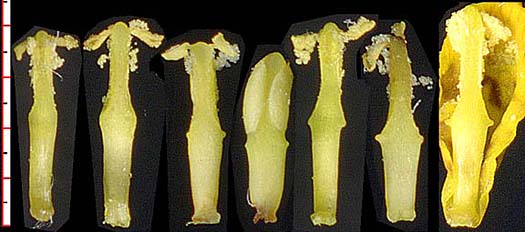B. trifoliolata & B. swaseyi Filament Teeth
by Bob Harms

In the following images no two stamens are from the same plant; filament appendages do not vary significantly on individual plants. None are from 'known hybrids.' [How to know a hybrid page.]

B. trifoliolata stamen types

B. swaseyi stamen types
Comparison of the two sets of images reveals an overlapping continuum from inappendiculate to saliently appendiculate.
The B. trifoliolata filament types range from clearly toothed at the right to the common toothless types at the left. The degree of swelling at the junction of the connective and the filament also varies a great deal.
B. swaseyi filaments range from nearly inappendiculate (on the far right) to broad, long, flexuous appendages on the left. The three in the center, with relatively terete projections represent the norm.
Hybrid Stamen Teeth

B. swaseyi X B. trifoliolata appendage types
Hybrid filaments, seen above, all show appendages, ranging from minimal (H1,H8) to large and flattened (H29). Most are terete and overall somewhat smaller than the B. swaseyi norm. And several of the hybrids show noticeable variation on the same plant (e.g., H8 above).
Variation as the Result of Introgressive Hybridization
The Texas hill country endemic B. swaseyi always occurs in association with B. trifoliolata and there is a
short period of overlap in their blooming time at the end of March and beginning of April. Seeds of hybrids have demonstrated good vitality. As a group
hybrids have blooming times with significantly longer overlap with both original species.
The wide variation in filament morphology found within both species, and the hybrids —
especially the presence of filament teeth with putative B. trifoliolata and significantly reduced filament teeth with putative B. swaseyi &mdash support a hypothesis of introgressive hybridization, probably having occurred for millennia in the B. swaseyi area, given that it has always been an associate of B. trifoliolata.
Further, given this view, one should expect to find toothed specimens of B. trifoliolata only in those areas where both species occur. The toothed B. trifoliolata of Adolf Scheele (1848) is from the hills of Comal County (near New Braunfels) — Ahrendt (1961, p. 354) indicates a specimen of B. swaseyi collected by Palmer in 1917 along rocky streams in this county. In 2004 and 2005 I surveyed B. trifoliolata stamens from 131 plants on a 50 acre tract with both species present and from 46 plants in Travis and Hays county with no B. swaseyi present. The results, given in the table below, support the connection of longer filament appendages with B. swaseyi.
|
|
toothless
|
min. nodule
|
clear nodule
|
strong nodule
|
total plants
|
|
Both Species Present
|
60% |
17% |
11%
|
10% |
131
|
|
B. swaseyi Absent
|
72%
|
24% |
0 |
0 |
46
|
Survey of 177 B. trifoliolata plants for filament teeth.
